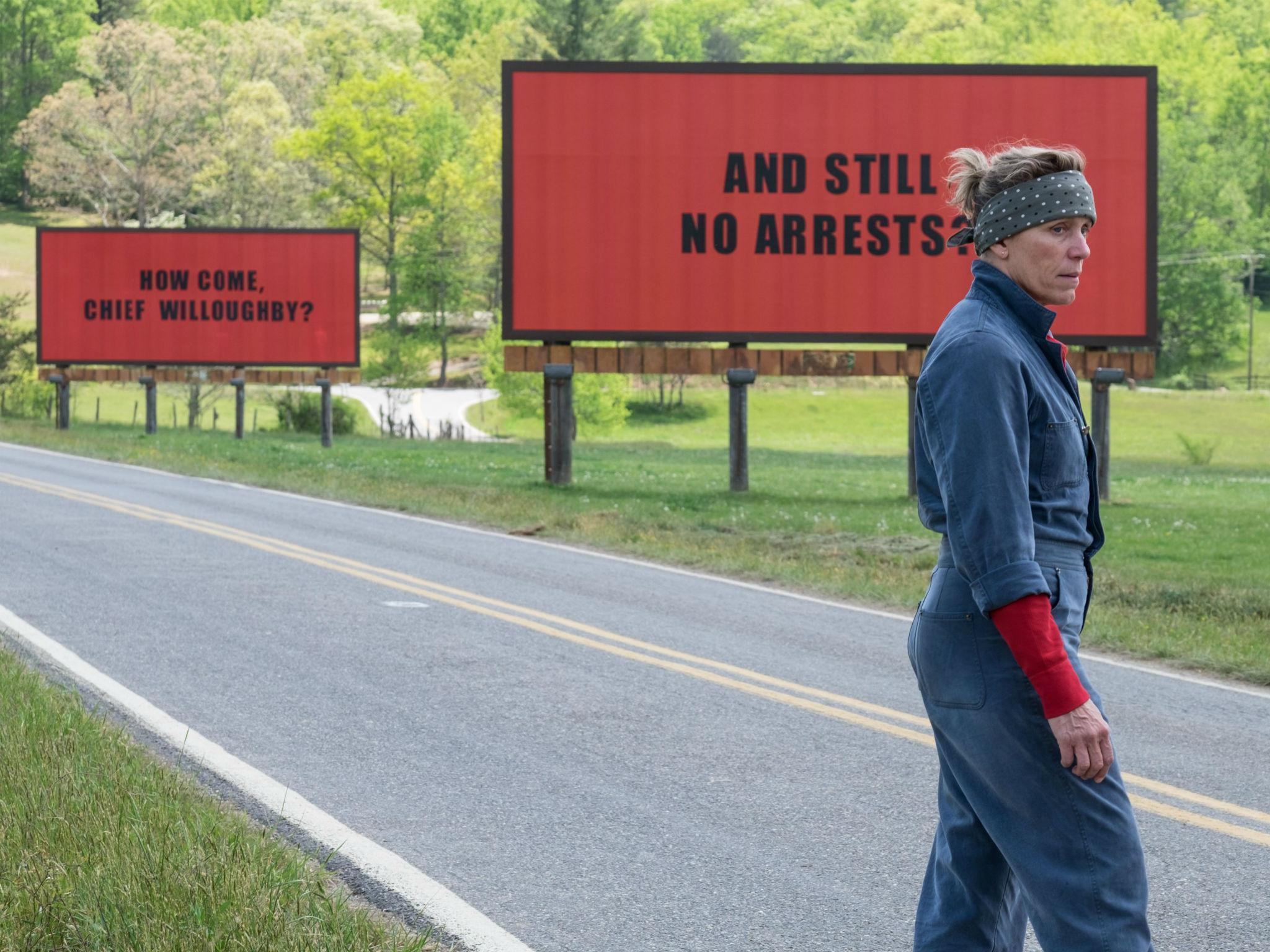
If Hannah Arendt can coin the ‘banality of evil’ then someone must have claimed the buffoonery of evil, even if only to refer to characters sprung from the mind of Martin McDonough. If you’re familiar with the director’s previous work, you’ll know what I mean. In Bruges the director introduced us to two squabbling hitmen as they grew bored on a European getaway. Seven Psychopaths featured a sextuplet of amoral thieves and killers repeatedly undone by their own stupidity. Now his latest film; Three Billboards outside Ebbing, Missouri tackles a police force rife with incompetence and violent misconduct.
One of
the few genuinely great working-class stories to emerge in the last few years, Three Billboards…centres on Mildred
Hayes (Frances McDormand), a bereaved single mother who hires the titular
billboards to chastise the local police force. Singling out Police Chief Bill
Willoughby (Woody Harrelson) for failing to catch the man who raped and
murdered her daughter. In Mildred’s eyes the local police are ‘too busy
torturing black folk’ to solve the case. Said torturer being his loyal lapdog
Officer Jason Dixon, whose crimes Willoughby nervously dismisses.
Now, make
no mistake the film is very good. Funny, poignant and dark, with outstanding
performances from McDormand and Rockwell. Yet this is another instance of a
white director, using a white lead, to cover an issue which predominantly
affects people of colour. Early last year the American Public Health
Association published a report that found that Black and Hispanic males were
almost twice as likely to be killed by police force than their white
counterparts. While Mildred’s rage over her daughter’s death is legitimate it
pales in comparison to the 55% of black homicides that go unsolved in the US
every year. McDonough is a talented storyteller but his distance from the issue
inevitably leads him to belie it. Predominantly in the way he frames Willoughby
and Dixon.
Admittedly Harrelson can play Willoughby
as an authoritarian brute, bearing down on Mildred in an interrogation room,
delivering threats to ruin her life. All to quickly though the film will
undercut this performance with reminders of his humanity, his vulnerability. He
is introduced to us as a family man, he spends time with Mildred earnestly
insisting that he wants to find her daughter’s killer. And then there’s the
kicker, he has a terminal illness. It feels like at every step we’re encouraged
to sympathise with this spineless brute. A man who not only enables Dixon’s
crimes but lavishes praise on him. Honestly at times he feels like a character
from a different film. One that didn’t feel like it had so much to say about
systemic racism within the police.
/cdn.vox-cdn.com/uploads/chorus_image/image/58380967/billboards1.0.jpg)
The film takes a similar approach
to Dixon, easily the more reprehensible of the two. Painted by his history as a
violent and unrepentant racist, having previously tortured a black suspect
during interrogation. Yet we crucially never see any of this take place. The
only act of racial profiling he commits during the film’s timeline is the off-screen
arrest of Mildred’s friend played by Amanda Warren. When he actually shares
screen-time with two African American characters they both display open
contempt for him without concern for any reproach. Remember, that this is set in a country where
black children have been shot dead for playing with toy guns. Granted one of
these characters is the new police chief and seeing him toss Dixon to the kerb
is fully intended as a satisfying moment of catharsis. However, the ease with
which Clarke Peters’ character can take charge of a police department
supposedly mired in systemic racism one again betrays McDonough’s naivety on
the subject.
Despite what we are told about Officer Dixon his on-screen
characterisation, much like Willoughby’s, feels designed to undermine his
authority and engender sympathy. Members of the public freely insult him, he lives
at home with his mother and whenever confronted with his wrongdoing he fearfully
denies it. He’s a terrified dog ashamed to have soiled the carpet, but with no
capacity to clean it. In short, he’s a far cry from real-life officers like Brian
Encinia; the state trooper who violently apprehended Sandra Bland shortly
before she died in custody or former Officer Philip Braisford who shot a
suspect with an AR-15 as he begged for his life earlier this year. These are
officers who confidently committed violent acts and remain unapologetic about
it to this day. No provocation, no
denials and no remorse. That’s the kind of misconduct McDonough supposedly
seeks to comment upon and woefully fails at.
Now, I’m not saying I wanted
Three Billboards… to feature scenes of violence against African Americans. In
case it’s not clear I see enough of that on the news. And yes, we should afford
McDonough some artistic license to deviate from reality. After all, no one was
expecting him to remake Serpico. It’s
only natural that characters like Willoughby and Dixon should warrant fleshing-out,
even humanising. But comparing these two goofballs to the actual cases of
police misconduct rings not of humanizing them, but romanticising. Comical
romanisation to be sure, on par with say, McDonough making a version of Spotlight where the priests acted like
Pepe Le Pew. But making lazy, corrupt and violent cops the butt of the joke is
a long way off examining the incendiary issure here. In doing so McDonough
blurs the reality behind the devastation these corrupt institutions wreak on
communities. Mischaracterising both the officers responsible and the issue Three Billboards… seeks to shine a light
on.
No comments:
Post a Comment